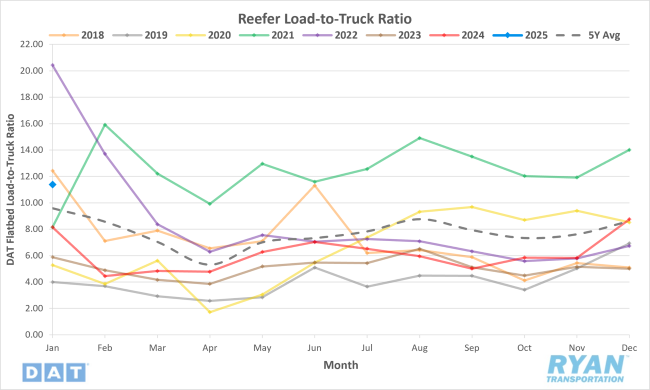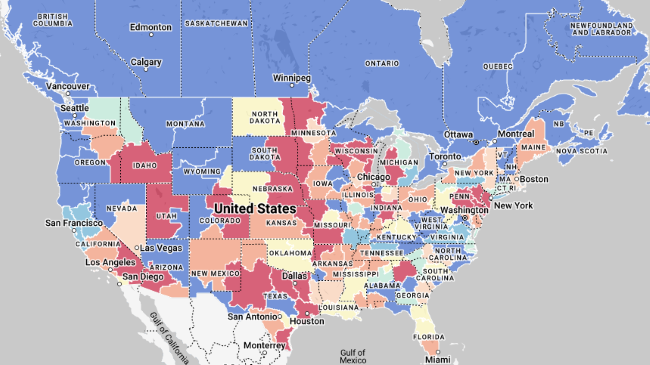Back to February 2025 Industry Update
February 2025 Industry Update: Reefer
Freezing temperatures led to a surge in reefer demand, driving rates up with it.
Spot Rates

Key Points
- The national average reefer spot rate excluding fuel registered a 2.6% increase MoM, or $0.05, in January to $2.12.
- On an annual basis, average reefer spot linehaul rates were 1.4% higher YoY compared to January 2024 and 0.8% below the LT average.
- Initially reported average reefer contract linehaul rates were up slightly by 0.2% MoM but remained just over 2% below average contract rates in January 2024.
Load-to-Truck Ratio

Key Points
- The reefer LTR registered a 29.9% increase MoM in January to 11.38.
- Compared to January 2024, the reefer LTR was up 39.5% YoY and 18.8% higher than the 5-year average.
- The reefer sector observed a 25.6% MoM increase in total load post volumes in January, while truck posts fell by 3.3% MoM, according to DAT load board data.
Market Conditions

Reefer Summary
The reefer market continued to demonstrate robust strength in January, buoyed in part by severe weather systems like Winter Storm Cora. Spot rate and tender rejection data reveal a sustained demand for temperature-controlled transportation, underscoring the critical role reefers play in maintaining the integrity of perishable goods during harsh climate conditions. Outperformance in the restaurant industry is also driving demand for temperature-controlled logistics higher. According to DAT and FreightWaves, in November, the Restaurant Performance Index (RPI) saw an increase reaching a value of 101.2. This was largely attributed to improved business outlooks among restaurant operators. The Expectations Index, which measures a six-month outlook, also rose to 102 (its second consecutive month above 100), indicating growing optimism about sales growth and economic conditions. These positive sentiments translate to steady demand for refrigerated services as restaurants anticipate higher consumption rates.
Avocados From Mexico was looking to make a touchdown on Sunday, February 9. The Super Bowl is the most significant occasion for Avocados From Mexico, with peak shipping season coinciding with the NFL end-of-season event in New Orleans this year. Over the course of a year, U.S. truckload carriers will move around 95,000 truckloads of avocados, with 97% crossing the southern border in Texas. The commercial zone crossing in Laredo, TX accounts for 55% of the volume, followed by Pharr, TX at 42%. According to Avocados From Mexico, the brand has almost doubled the volume of Mexican avocados imported to the U.S. in seven years to meet the growing demand. Today, 8 in 10 avocados in the U.S. come from Mexico, with a new record of 2.5B lbs. imported to the U.S. in 2023. Avocados From Mexico are responsible for approximately 95% of avocado sales in the U.S. during Super Bowl week, with 250M lbs. of avocados sold.
According to the USDA, national truckload produce volumes are trailing last year by just over 6%, impacted in part by the devastating wildfires in California. Raging flames, persistent smoke and damaging winds are expected to result in significant crop damage for farmers throughout Southern California. Alba Velasquez, the Executive Director of the Los Angeles Food Policy Council, told ABC News that farmers face two hurdles, namely economic and air quality challenges. Velasquez stated that approximately 24 farms are currently affected by the Eaton Fire, with numbers increasing daily due to air quality issues, flames and economic impacts. Peter Ansel from the California Farmers Bureau noted that smoke poses distinct threats to people (especially farm workers working in the produce fields), animals and crops. Meanwhile, other farmers struggle to sell their goods since many farmers markets in Los Angeles County are shut down or have reduced visitors.